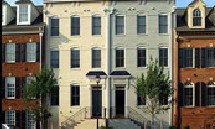Most states and participating jurisdictions provide homeowner rehab assistance through one of two channels: (i) deferred payment and non-interest bearing loans or (ii) grants and in-kind assistance.
Interest subsidies and
loan guarantees are other forms of financial assistance to support homeowner rehab efforts.
Deferred payment loans and non-interest bearing loans
Deferred payment loans and non-interest bearing loans are low-cost loans that enable the borrower to defer repayment with no or very low interest, typically upon sale of the home.
- In Minnesota, the HOME Consortium, a coalition of three counties that distributes HOME funds to participating jurisdictions, offers a Homeowner Rehabilitation Deferred Loan, a no-interest deferred loan of up to $20,000 for households earning below 80 percent of area median income. The funds can be used for priority home improvements that are critical to the safety of the home, such as roof or window replacements and plumbing repairs. There are no monthly payments and the loan is repayable upon sale or transfer of the property. Click here to leave this site and learn more about the Minnesota HOME Consortium.
- The Nevada Housing Division distributes funds from the state's Low Income Housing Trust Fund to participating localities to match federal HOME dollars for homeownership rehab assistance. The Rural Nevada Development Corporation (RNDC), one recipient of the state’s trust fund resources, provides deferred loans for home rehab assistance to households in rural Clark County, Nevada. The deferred loan does not accrue interest or require monthly payments, but must be repaid when the property is sold or is no longer the primary residence of the homeowner. Click here to leave this site read more about the state program and work in Clark County.
Back to top
Grants and in-kind assistance
Unlike borrowers who benefit from low-cost loans, grant recipients are not expected to repay funds. Grants can take a number of forms, including forgivable loans that do not need to be repaid if the borrower remains in the home for a set period of time. Providing in-kind assistance, including donation of materials and labor, is another common approach to making critical home repairs. The national non-profit organization,
Rebuilding Together, is a leading organization that provides volunteer-based homeowner rehab services for low-income families in communities across the U.S.
- In Casper, Wyoming, the Housing and Community Development Division partners with a faith-based volunteer group to rehabilitate homes for homeowners for one week each year. Homeowners must apply to receive volunteer services for home repair and approximately 20 homes are selected annually. Volunteers replace roofs, windows, exterior doors, storm windows and storm doors, paint home exteriors, repair fences, or build ramps for persons who need wheelchair accessibility to their home. Equipment and supplies are paid for by the city using CDBG funds. Click here for more information about Casper's grant program.
- The City of Lake Charles, Louisiana uses HOME funds to provide rehab or reconstruction grants to eligible homeowners. When the cost of repairs exceeds the available grant funding, the homeowner may supplement the grant award with private funds that they secure independently. The grant program funds are available to elderly, disabled, and single-parent headed households. Click here for more information on the Lake Charles Rehabilitation or Reconstruction Grant Program [PDF].
- Irvine, California offers one-time grants of up to $5,000 to eligible homeowners. The funds are set aside for emergency code-related repairs that are necessary to prevent injury to occupants, such as leaky roofs, faulty wiring or plumbing. Click here to learn more about the City of Irvine's Residential Repair Program.
- Through its Home-Owner Rehabilitation Program, the Kansas Housing Resource Corporation (KHRC), a subsidiary of the Kansas Development Finance Authority, distributes HOME funds to localities to provide no-interest loans to income-eligible homeowners. Local municipalities distribute the assistance in the form of deferred loans for emergency and exterior repairs. The loans are non-interest bearing and require repayment only if the property is sold within three years.
In 2008-2009, KHRC awarded $1.925 million to nine communities for rehab of 77 homes. Currently, 29 communities are implementing affordable owner-occupied housing rehab programs with approximately $5.5 million of HOME funds.
Click here to read more about KHRC.

